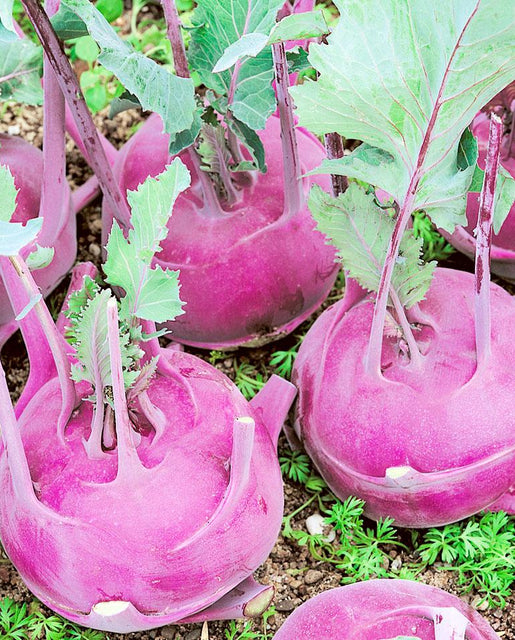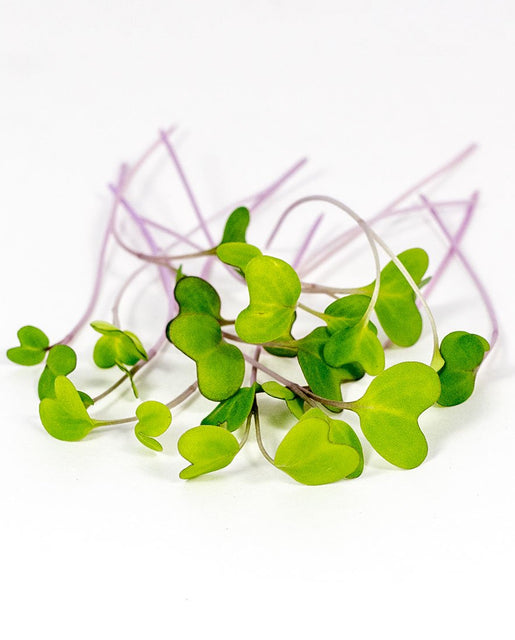For Product Registration and general enquires please contact us
Purple Vienna Organic
$7.99 – $31.99
Purple Vienna Organic kohlrabi is an old heirloom variety that has always enjoyed its status as one of the standards for the home and market. Purple skin covers faintly greenish-white flesh with superb flavour.
Shipping & Returns
West Coast Seeds ships anywhere in North America. However, we are not able to ship garlic, potatoes, asparagus crowns, bulbs, onion sets, Mason bee cocoons, or nematodes outside of Canada. We regret, we cannot accept returns or damages for orders outside of Canada. The minimum shipping charge to the US is $9.99.
Description
More details about Purple Vienna Organic
Purple Vienna Organic kohlrabi is an old heirloom variety that has always enjoyed its status as one of the standards for the home and market. Purple skin covers faintly greenish-white flesh with superb flavour. The tops are small, and the leaves are both colourful and edible. Just treat them like you would kale. Harvest the attractive purple kohlrabis at 6cm (2½”) in diameter for the finest texture. Direct sow in early spring for a summer harvest, and again in August to harvest in the cool weather of the fall and winter. This is the most economical kohlrabi to use for microgreens, and their flavour is exceptional. Matures in 55-69 days. (Open-pollinated seeds)-
- Certified Organic
- Heirloom seeds
- Tasty, edible tops
- Matures in 55-69 days
All About Purple Vienna Organic
Latin
Brassica oleracea var. gongylodes
Family: Brassicaceae
Difficulty
Easy
We Recommend
: Kolibri (KH434). We don’t recommend this wonderful hybrid kohlrabi for any other reason than how splendid looking it is in the garden. Kolibri has the same fine flavour and texture as Kongo, but hey – it’s bright purple! More gardeners need to grow familiar with this nutritious, easy-to-grow vegetable.
Season & Zone
Season: Cool season
Exposure: Full-sun
Timing
Direct sow several times during the four to six weeks after the last frost date for a crop to mature starting in about 8 weeks. Sow again after mid-July to early August for fall and winter crops. Planting between mid-May and mid-July causes kohlrabi to mature in hot weather, resulting in inferior bulbs. In short season areas, start kohlrabi indoors in cell trays about 4 weeks before the last frost date and transplant out once day time temperatures are steadily above 10°C (50°F). Optimal soil temperature for germination: 10-30°C (50-85°F). Seeds should germinate in 7-10 days.
Starting
Sow seeds 5mm (¼”) deep with plants spaced 10-15cm (4-6″) apart in rows 30-45cm (12-18″) apart.
Days to Maturity:
From direct sowing.
Growing
Ideal pH: 6.0-6.8. Kohlrabi is a moderate to heavy feeder that does best in humus-rich soil amended with composted manure. Mix ¼-½ cup complete organic fertilizer into the soil under each plant.
Harvest
Spring-sown kohlrabi will get larger than tennis balls in fair soil, but if you pick them when they are still less than 5-8cm (2-3″) in diameter they will be sweet and tender. Fall-grown kohlrabi can grow larger yet stay tender. Kohlrabi is frost-hardy, and may last well beyond Christmas in mild winter areas.
Seed Info
In optimal conditions, at least 80% of the seeds will germinate. Usual seed life: 3 years. Per 100′ row: 360 seeds, per acre: 104M seeds.
Diseases & Pests
Protect from cabbage moths and other insect pests with floating row cover. Prevent disease with a strict 4-year crop rotation; avoiding planting Brassicas in the same spot more than once every four years.
Companion Planting
A worthy companion for beets, Brassicas, cucumbers, and onions. Avoid planting near peppers, pole beans, strawberries, and tomatoes.






How to Grow Kohlrabi

Step 1: Timing
Direct sow several times during the four to six weeks after the last frost date for a crop to mature starting in about 8 weeks. Sow again after mid-July to early August for fall and winter crops. Planting between mid-May and mid-July causes kohlrabi to mature in hot weather, resulting in inferior bulbs. In short season areas, start kohlrabi indoors in cell trays about 4 weeks before the last frost date and transplant out once day time temperatures are steadily above 10°C (50°F). Optimal soil temperature for germination: 10-30°C (50-85°F). Seeds should germinate in 7-10 days.
Step 2: Starting
Sow seeds 5mm (¼”) deep with plants spaced 10-15cm (4-6″) apart in rows 30-45cm (12-18″) apart.
Step 3: Growing
Ideal pH: 6.0-6.8. Kohlrabi is a moderate to heavy feeder that does best in humus-rich soil amended with composted manure. Mix ¼-½ cup complete organic fertilizer into the soil under each plant.
Step 4: Germination
Days to maturity: From direct sowing. In optimal conditions, at least 80% of the seeds will germinate. Usual seed life: 3 years. Per 100′ row: 360 seeds, per acre: 104M seeds.
Step 5: Harvest
Spring-sown kohlrabi will get larger than tennis balls in fair soil, but if you pick them when they are still less than 5-8cm (2-3″) in diameter they will be sweet and tender. Fall-grown kohlrabi can grow larger yet stay tender. Kohlrabi is frost-hardy, and may last well beyond Christmas in mild winter areas.
Tips!
Disease & Pests: Protect from cabbage moths and other insect pests with floating row cover. Prevent disease with a strict 4-year crop rotation; avoiding planting Brassicas in the same spot more than once every four years. Companion Planting: A worthy companion for beets, Brassicas, cucumbers, and onions. Avoid planting near peppers, pole beans, strawberries, and tomatoes.Additional information
| Matures | in 55-69 days |
|---|---|
| Season | Cool season |
| Exposure | Full sun |
| Quantity | 0.5g, 2g, 8g, 100g |
You must be logged in to post a review.










Reviews
There are no reviews yet.